Satas D., Tracton A.A. (ed.). Coatings Technology Handbook
Подождите немного. Документ загружается.

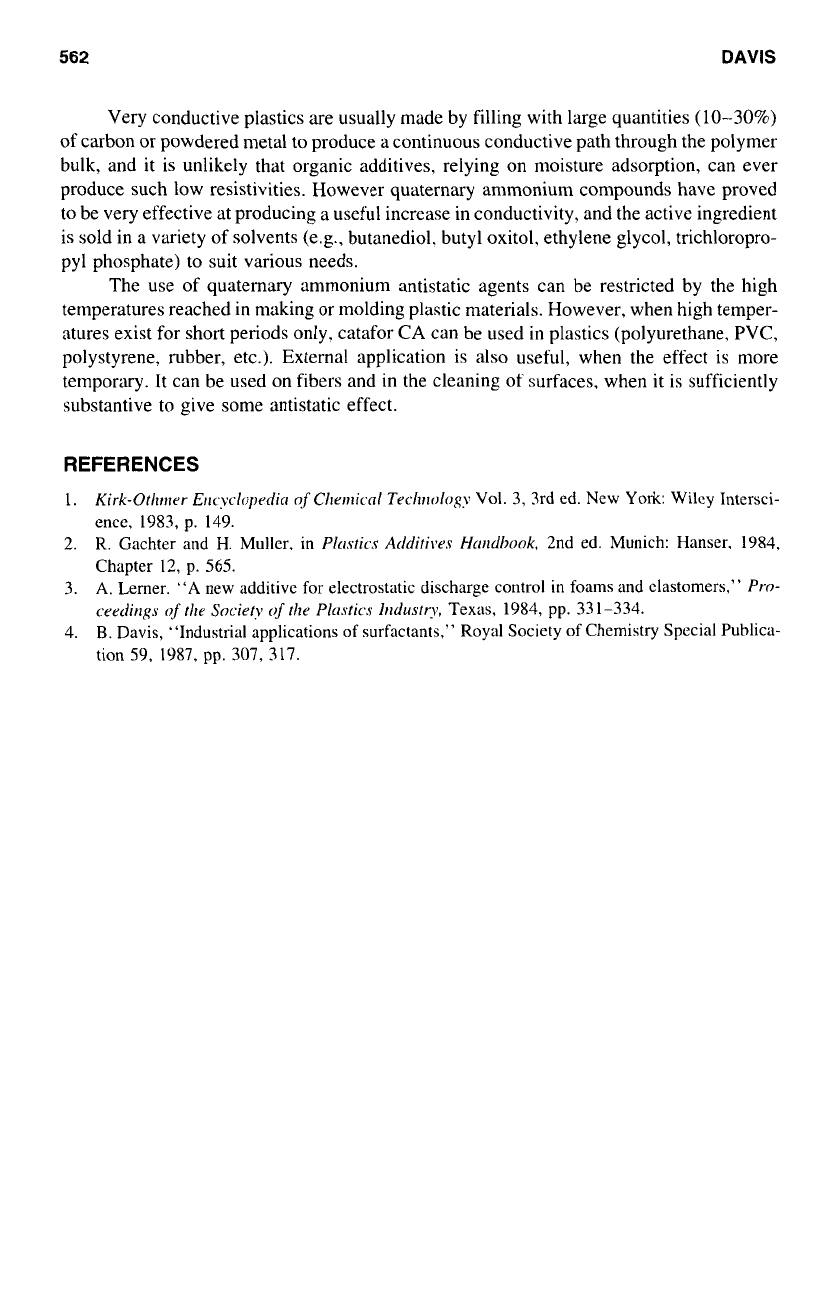
562
DAVIS
Very conductive plastics are usually made by filling with large quantities
(10-30%)
of
carbon or powdered metal to produce a continuous conductive path through the polymer
bulk, and it is unlikely that organic additives, relying on moisture adsorption, can ever
produce such low resistivities. However quaternary ammonium compounds have proved
to
be very effective at producing
a
useful increase in conductivity, and the active ingredient
is
sold in
a
variety of solvents (e.g., butanediol. butyl oxitol, ethylene glycol, trichloropro-
pyl phosphate)
to
suit various needs.
The use of quaternary ammonium antistatic agents can be restricted by the high
temperatures reached in making or molding plastic materials. However, when high temper-
atures exist for short periods only. catafor
CA
can be used
in
plastics (polyurethane, PVC,
polystyrene, rubber, etc.). External application is also useful, when the effect is more
temporary. It can be used on fibers and in the cleaning of surfaces, when it is sufficiently
substantive to give some antistatic effect.
REFERENCES
I.
Kirk-Othrwr
Erfcyclopedin
nfCllrrnicn(
TrchrIolop
Vol.
3, 3rd ed.
New
York:
Wiley Intersci-
2.
R. Gachter and
H.
Muller, in
PIutics
Additi~~s
Hmdlwok,
2nd ed. Munich: Hanser. 1984,
ence, 1983, p. 149.
Chapter 12, p.
565.
certlir~gs
of
the
Society
of
the
Plastics
Irfdustry,
Texas, 1984, pp. 33 1-334.
tion
59,
1987, pp. 307,
317.
3.
A.
Lerner.
“A
new additive for electrostatic discharge control in foams and elastomers,”
Pro-
4.
B.
Davis, “Industrial applications of surfactants,” Royal Society of Chemistry Special Publica-
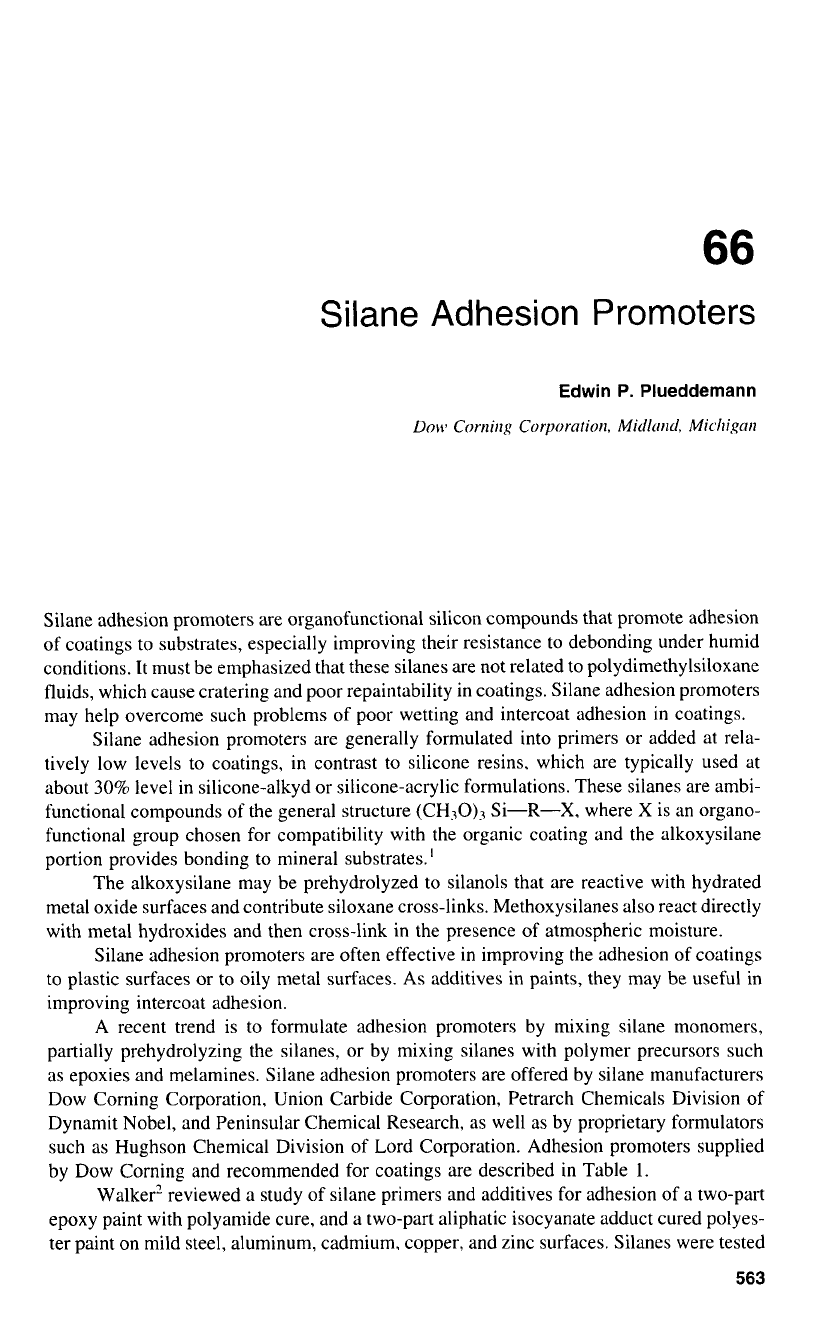
Silane Adhesion Promoters
Silane adhesion promoters are organofunctional silicon compounds that promote adhesion
of
coatings to substrates, especially improving their resistance to debonding under humid
conditions. It must be emphasized that these silanes are not related to polydimethylsiloxane
fluids, which cause cratering and poor repaintability in coatings. Silane adhesion promoters
may help overcome such problems of poor wetting and intercoat adhesion
in
coatings.
Silane adhesion promoters are generally formulated into primers or added at rela-
tively low levels to coatings, in contrast to silicone resins. which are typically used at
about
30%
level in silicone-alkyd or silicone-acrylic formulations. These silanes are ambi-
functional compounds of the general structure (CH30)3 Si-R-X, where
X
is an organo-
functional group chosen for compatibility with the organic coating and the alkoxysilane
portion provides bonding to mineral substrates.'
The alkoxysilane may be prehydrolyzed to silanols that are reactive with hydrated
metal oxide surfaces and contribute siloxane cross-links. Methoxysilanes also react directly
with metal hydroxides and then cross-link in the presence of atmospheric moisture.
Silane adhesion promoters are often effective in improving the adhesion of coatings
to plastic surfaces or to oily metal surfaces. As additives in paints, they may be useful in
improving intercoat adhesion.
A recent trend is
to
formulate adhesion promoters by mixing silane monomers,
partially prehydrolyzing the silanes, or by mixing silanes with polymer precursors such
as
epoxies and melamines. Silane adhesion promoters are offered by silane manufacturers
Dow Corning Corporation, Union Carbide Corporation, Petrarch Chemicals Division
of
Dynamit Nobel, and Peninsular Chemical Research, as well
as
by proprietary formulators
such
as
Hughson Chemical Division of Lord Corporation. Adhesion promoters supplied
by Dow Corning and recommended for coatings are described in Table
1.
Walker' reviewed
a
study of silane primers and additives for adhesion of
a
two-part
epoxy paint with polyamide cure, and a two-part aliphatic isocyanate adduct cured polyes-
ter paint on mild steel, aluminum, cadmium. copper, and zinc surfaces. Silanes were tested
563
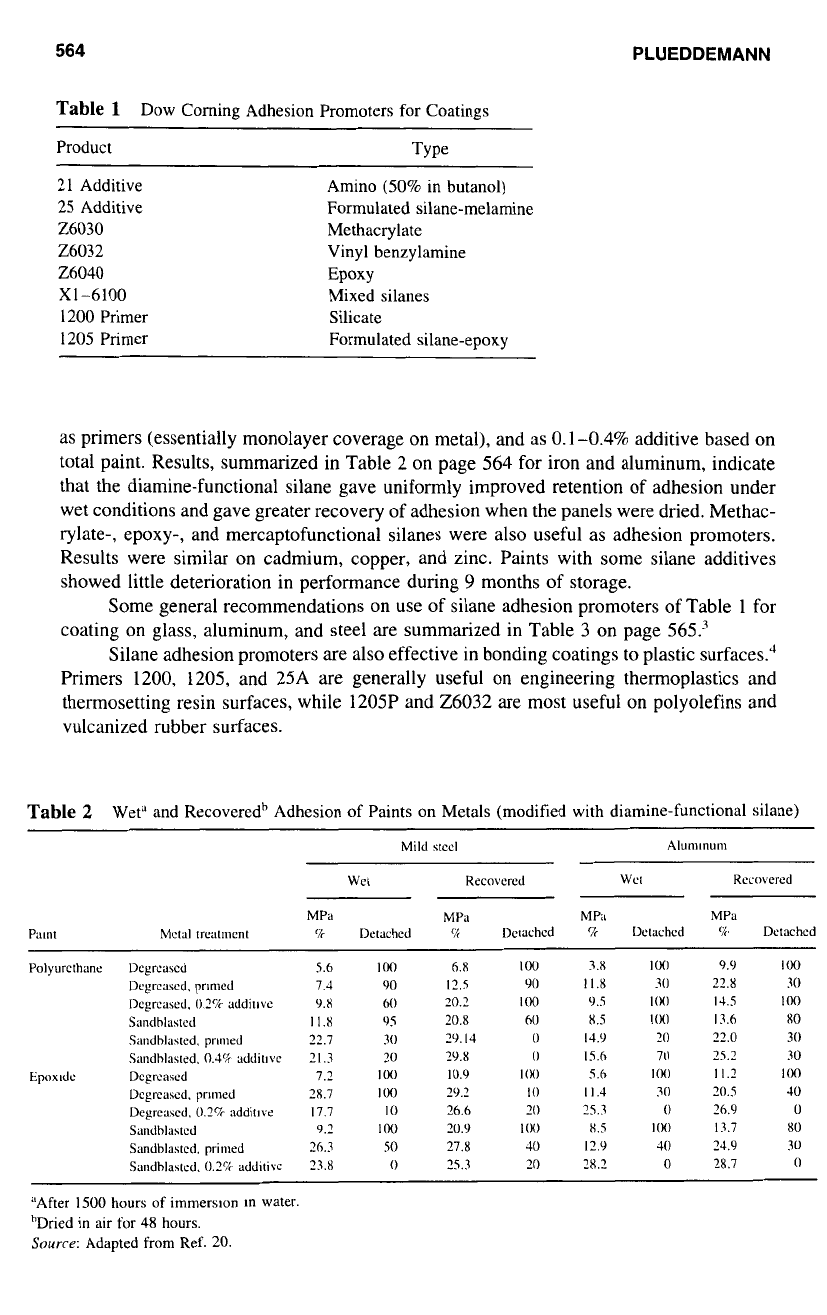
564
PLUEDDEMANN
Table
1
Dow Coming Adhesion Promoters
for
Coatings
Product Type
2
1
Additive Amino (50% in butanol)
25
Additive Formulated silane-melamine
26030 Methacrylate
26032 Vinyl benzylamine
26040 EPOXY
1200 Primer Silicate
1205 Primer Formulated silane-epoxy
X1-6100 Mixed silanes
as primers (essentially monolayer coverage on metal), and as 0.1-0.4% additive based on
total paint. Results, summarized in Table 2 on page
564
for iron and aluminum, indicate
that the diamine-functional silane gave uniformly improved retention of adhesion under
wet conditions and gave greater recovery of adhesion when the panels were dried. Methac-
rylate-, epoxy-, and mercaptofunctional silanes were also useful
as
adhesion promoters.
Results were similar on cadmium, copper, and zinc. Paints with some silane additives
showed little deterioration in performance during
9
months
of
storage.
Some general recommendations on use of silane adhesion promoters of Table
1
for
coating on glass, aluminum, and steel are summarized in Table 3 on page 565.3
Silane adhesion promoters are also effective in bonding coatings
to
plastic surfaces."
Primers 1200, 1205, and 25A are generally useful
on
engineering thermoplastics and
thermosetting resin surfaces, while 1205P and 26032 are most useful on polyolefins and
vulcanized rubber surfaces.
Table
2
Wet" and Recoveredh Adhesion
of
Paints on Metals (modified with diamine-functional silane)
Mild
steel
Alummum
Wet
Recovered
Wet
Recovered
M
Pa
MPa
MPa
M
Pa
Palllt
Metal
treatment
'ic
Detached
'2
Detached
R
Dctachcd
'2,
Detached
5.6
7.4
9.x
1I.X
22.7
21.3
7.2
28.7
17.7
9.2
26.3
23.8
6.X
12,s
20.2
20.8
2Y.14
2Y.X
10.9
9.2
26.6
20.')
27.8
75.3
3.X
I
1.8
Y.S
x.5
14.9
lS.h
S.6
11.4
2.5.3
x.5
l2.Y
2x2
9.9
22.8
I43
13.6
22.0
25.2
11.2
20.5
26.9
13.7
24.9
28.7
"After
1500
hours
of
immerslon
m
water
hDried in
air
for
48
hours.
Source:
Adapted
from Ref.
20.
~~
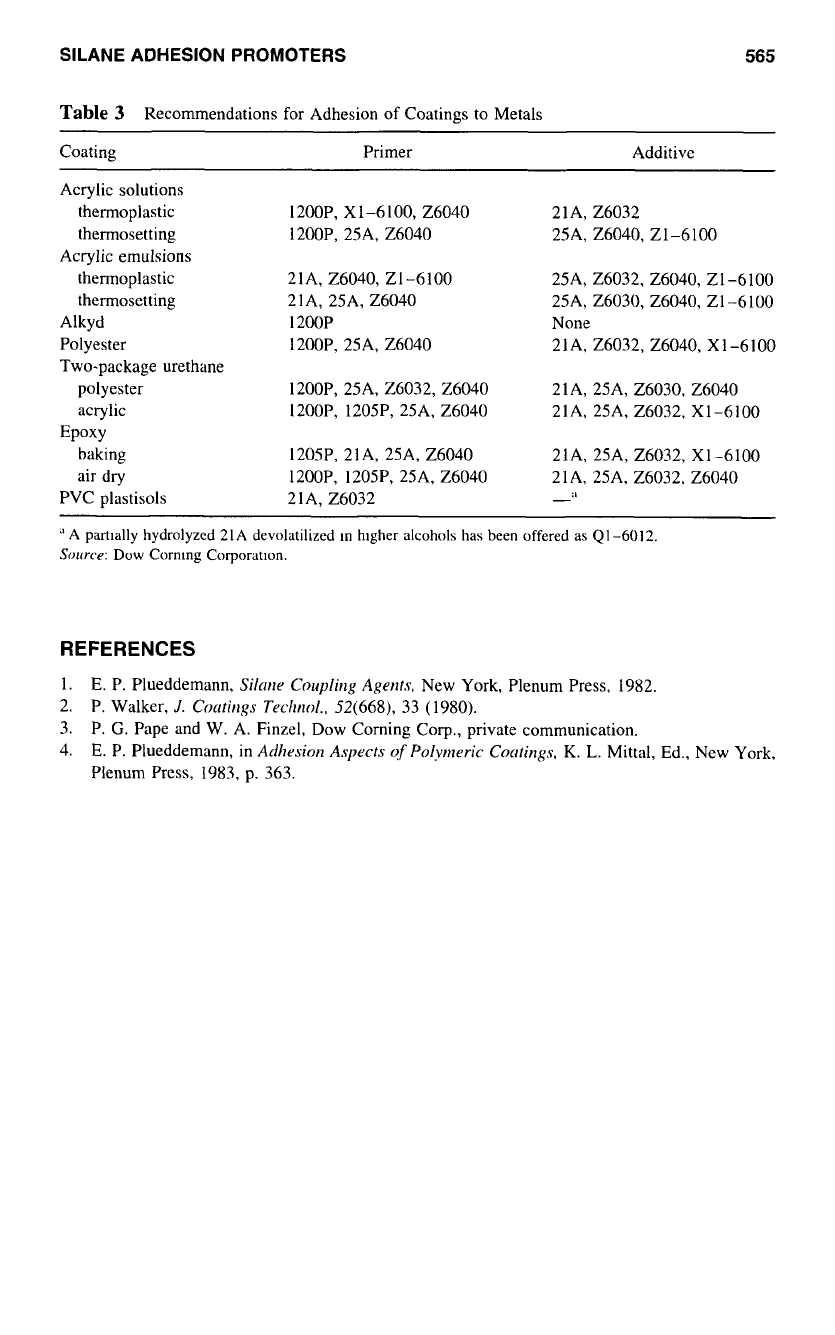
SILANE ADHESION
PROMOTERS
565
Table
3
Recommendations for Adhesion
of
Coatings to Metals
Coating Primer Additive
Acrylic solutions
thermoplastic
thermosetting
Acrylic emulsions
thermoplastic
thermosetting
Alkyd
Polyester
Two-package urethane
polyester
acrylic
baking
air dry
EPOXY
PVC plastisols
1200P. X 1-6
100,
26040
1200P, 25A, 26040
21A, 26040,
21-6100
21A, 25A, 26040
1200P
1200P, 25A, 26040
1200P, 25A, 26032, 26040
1200P, 1205P, 25A, 26040
1205P, 21A, 25A, 26040
1200P, 1205P, 25A, 26040
2
1
A, 26032
21A, 26032
25A, 26040, 21-6100
25A, 26032,26040, 21-6100
25A, 26030, 26040, 21-6100
None
21A, 26032, 26040, X1-6100
21A, 25A, 26030,26040
21.4, 25A, 26032, X1-6100
21A, 25A, 26032, XI-6100
21A, 25A, 26032, 26040
I
-
“A
partially
hydrolyzed
21A
devolatilized
In
hlgher alcohols has been offered as
QI-6012.
Source: Dow
Cornlng
Corporatlon.
~~
REFERENCES
1. E. P. Plueddemann,
Silane
Coupling
Agents,
New York, Plenum Press, 1982.
2. P. Walker,
J.
Cocctings
Techno/.,
52(668), 33 (1980).
3.
P.
G. Pape and W. A. Finzel, Dow Corning
Corp.,
private communication.
4.
E.
P. Plueddemann, in
Adhesion Aspects
qf
Po/.vmeric Cocctings,
K.
L.
Mittal, Ed., New York,
Plenum Press, 1983, p. 363.
This Page Intentionally Left Blank
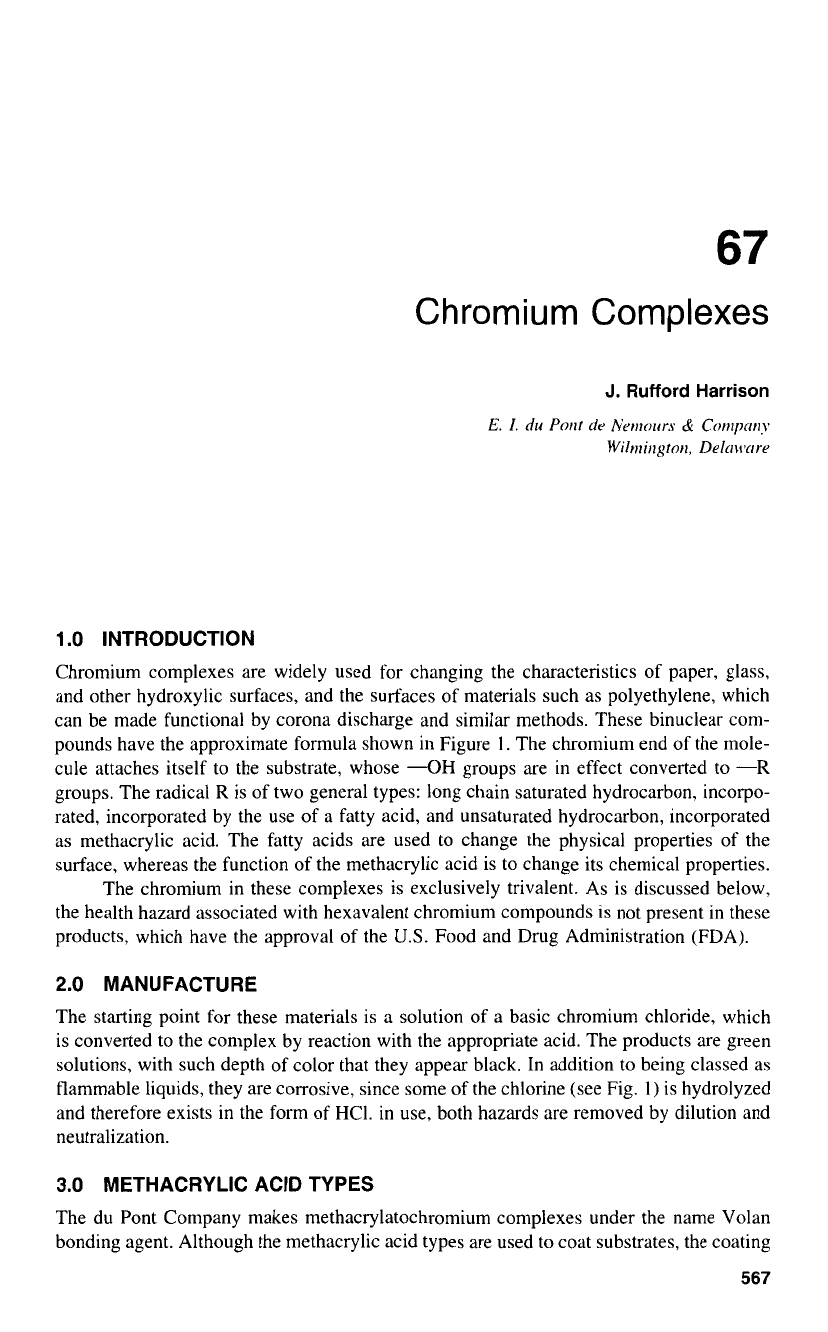
67
Chromium Complexes
1
.O
INTRODUCTION
Chromium complexes are widely used for changing the characteristics of paper, glass,
and other hydroxylic surfaces, and the surfaces of materials such as polyethylene, which
can be made functional by corona discharge and similar methods. These binuclear com-
pounds have the approximate formula shown in Figure
1.
The chromium end
of
the mole-
cule attaches itself to the substrate, whose
"OH
groups are in effect converted
to
-R
groups. The radical
R
is of two general types: long chain saturated hydrocarbon, incorpo-
rated, incorporated by the use
of
a fatty acid, and unsaturated hydrocarbon, incorporated
as methacrylic acid. The fatty acids are used to change the physical properties
of
the
surface, whereas the function of the methacrylic acid is
to
change its chemical properties.
The chromium in these complexes is exclusively trivalent. As is discussed below,
the health hazard associated with hexavalent chromium compounds is not present in these
products, which have the approval of the
U.S.
Food and Drug Administration (FDA).
2.0
MANUFACTURE
The starting point for these materials is
a
solution
of
a basic chromium chloride, which
is converted to the complex by reaction with the appropriate acid. The products are green
solutions, with such depth of color that they appear black. In addition
to
being classed as
flammable liquids, they are corrosive, since some
of
the chlorine (see Fig.
1)
is hydrolyzed
and therefore exists in the form of
HCI.
in use, both hazards are removed by dilution and
neutralization.
3.0
METHACRYLIC ACID TYPES
The du Pont Company makes methacrylatochromium complexes under the name Volan
bonding agent. Although the methacrylic acid types are used
to
coat substrates, the coating
567
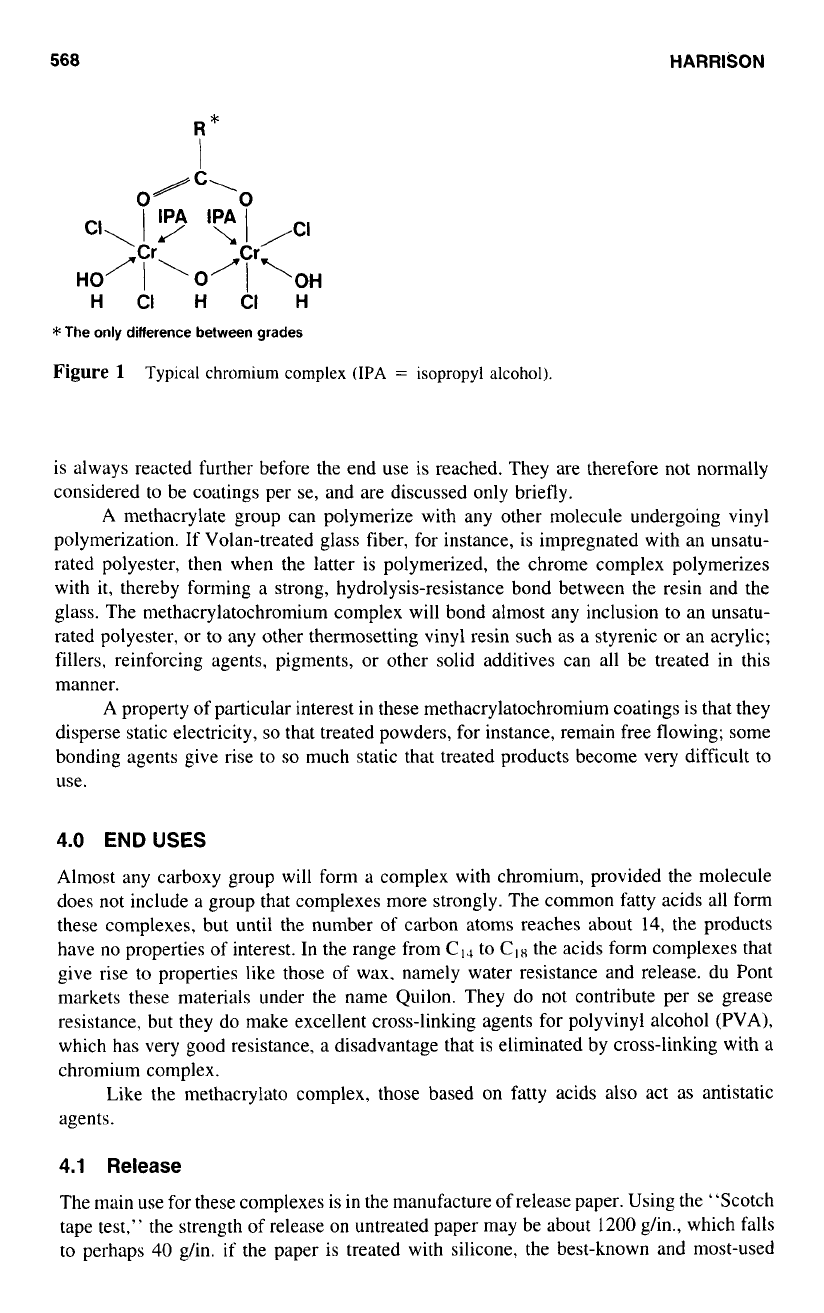
568
R*
l
HARRISON
H
Cl
H
Cl
H
*The
only
difference between grades
Figure
1
Typical chromium
complex
(IPA
=
isopropyl
alcohol).
is always reacted further before the end use is reached. They are therefore not normally
considered to be coatings per se, and are discussed only briefly.
A methacrylate group can polymerize with any other molecule undergoing vinyl
polymerization. If Volan-treated glass fiber, for instance, is impregnated with an unsatu-
rated polyester, then when the latter is polymerized, the chrome complex polymerizes
with it, thereby forming a strong, hydrolysis-resistance bond between the resin and the
glass. The methacrylatochromium complex will bond almost any inclusion to an unsatu-
rated polyester, or to any other thermosetting vinyl resin such as a styrenic or an acrylic;
fillers, reinforcing agents, pigments, or other solid additives can all be treated in this
manner.
A property
of
particular interest in these methacrylatochromium coatings is that they
disperse static electricity,
so
that treated powders, for instance, remain free flowing; some
bonding agents give rise to
so
much static that treated products become very difficult to
use.
4.0
END
USES
Almost any carboxy group will form a complex with chromium, provided the molecule
does not include a group that complexes more strongly. The common fatty acids all
form
these complexes, but until the number of carbon atoms reaches about
14,
the products
have no properties
of
interest. In the range from
C14
to
Clx
the acids form complexes that
give rise to properties like those
of
wax. namely water resistance and release. du Pont
markets these materials under the name Quilon. They do not contribute per se grease
resistance, but they do make excellent cross-linking agents for polyvinyl alcohol (PVA),
which has very good resistance. a disadvantage that is eliminated by cross-linking with a
chromium complex.
Like the methacrylato complex, those based on fatty acids also act as antistatic
agents.
4.1
Release
The main use for these complexes is in the manufacture of release paper. Using the “Scotch
tape test,” the strength
of
release on untreated paper may be about 1200 g/in., which falls
to
perhaps 40 g/in.
if
the paper is treated with silicone, the best-known and most-used
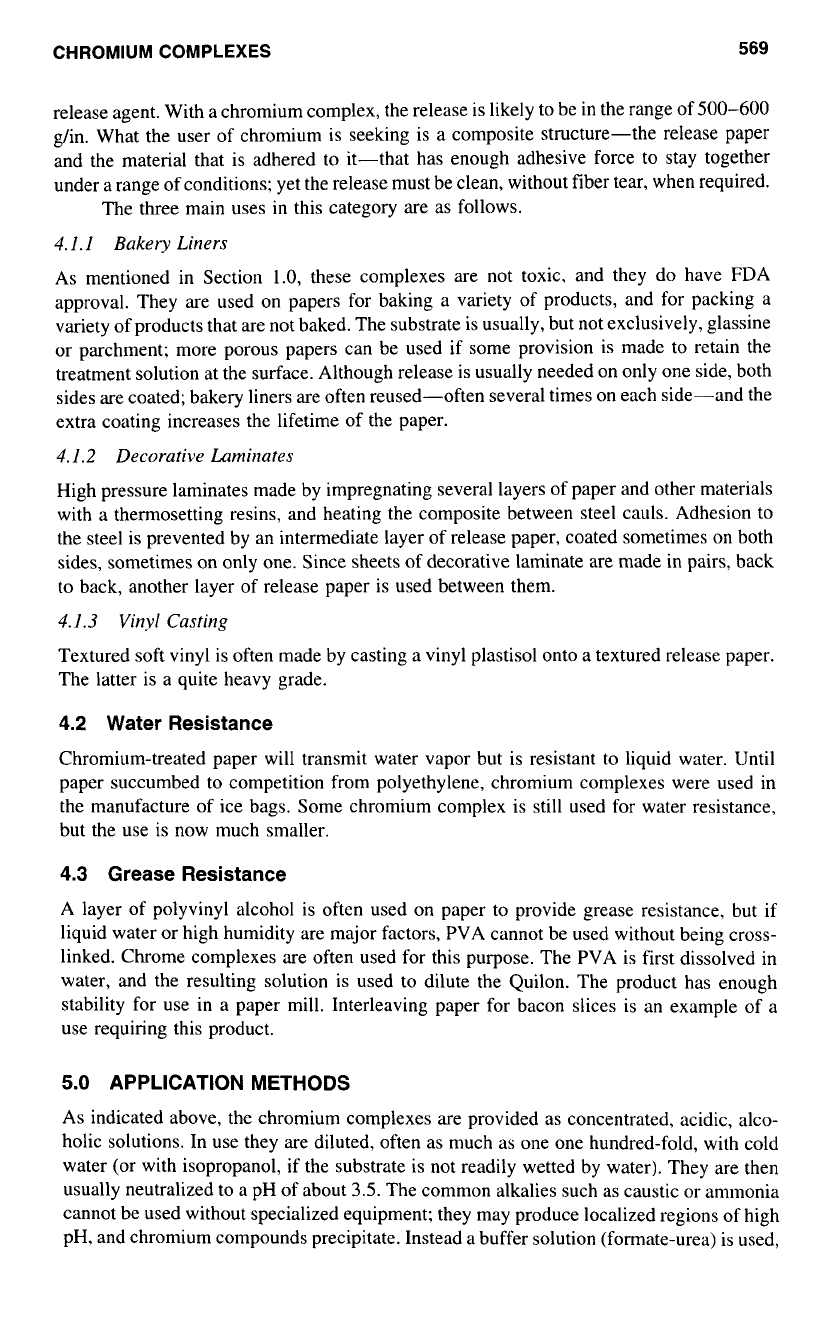
CHROMIUM COMPLEXES
569
release agent. With a chromium complex, the release is likely to be in the range of
500-600
ghn. What the user
of
chromium is seeking is
a
composite structure-the release paper
and the material that is adhered
to
it-that has enough adhesive force to stay together
under a range of conditions; yet the release must be clean, without fiber tear, when required.
The three main uses in this category are
as
follows.
4.1.1
Bakery Liners
As mentioned in Section
1.0,
these complexes are not toxic. and they do have FDA
approval. They are used on papers for baking
a
variety
of
products, and for packing a
variety of products that are not baked. The substrate is usually, but not exclusively, glassine
or parchment; more porous papers can be used if some provision is made to retain the
treatment solution at the surface. Although release is usually needed on only one side, both
sides are coated; bakery liners are often reused-often several times on each side-and the
extra coating increases the lifetime of the paper.
4.1.2
Decorative Laminates
High pressure laminates made by impregnating several layers of paper and other materials
with
a
thermosetting resins, and heating the composite between steel cauls. Adhesion to
the steel is prevented by an intermediate layer of release paper, coated sometimes on both
sides, sometimes on only one. Since sheets
of
decorative laminate are made in pairs, back
to
back, another layer of release paper is used between them.
4.1.3
Vinyl Casting
Textured soft vinyl is often made by casting
a
vinyl plastisol onto
a
textured release paper.
The latter is a quite heavy grade.
4.2
Water Resistance
Chromium-treated paper will transmit water vapor but is resistant
to
liquid water. Until
paper succumbed
to
competition from polyethylene, chromium complexes were used in
the manufacture of ice bags. Some chromium complex is still used for water resistance,
but the use is now much smaller.
4.3 Grease Resistance
A layer of polyvinyl alcohol is often used on paper to provide grease resistance, but if
liquid water or high humidity are major factors, PVA cannot be used without being cross-
linked. Chrome complexes are often used for this purpose. The PVA is first dissolved in
water, and the resulting solution is used to dilute the Quilon. The product has enough
stability for use in a paper mill. Interleaving paper for bacon slices is an example of
a
use requiring this product.
5.0
APPLICATION METHODS
As indicated above, the chromium complexes are provided
as
concentrated, acidic, alco-
holic solutions. In use they are diluted, often as much
as
one one hundred-fold, with cold
water (or with isopropanol, if the substrate is not readily wetted by water). They are then
usually neutralized to
a
pH
of
about
3.5.
The common alkalies such
as
caustic or ammonia
cannot be used without specialized equipment; they may produce localized regions
of
high
pH, and chromium compounds precipitate. Instead
a
buffer solution (formate-urea) is used,
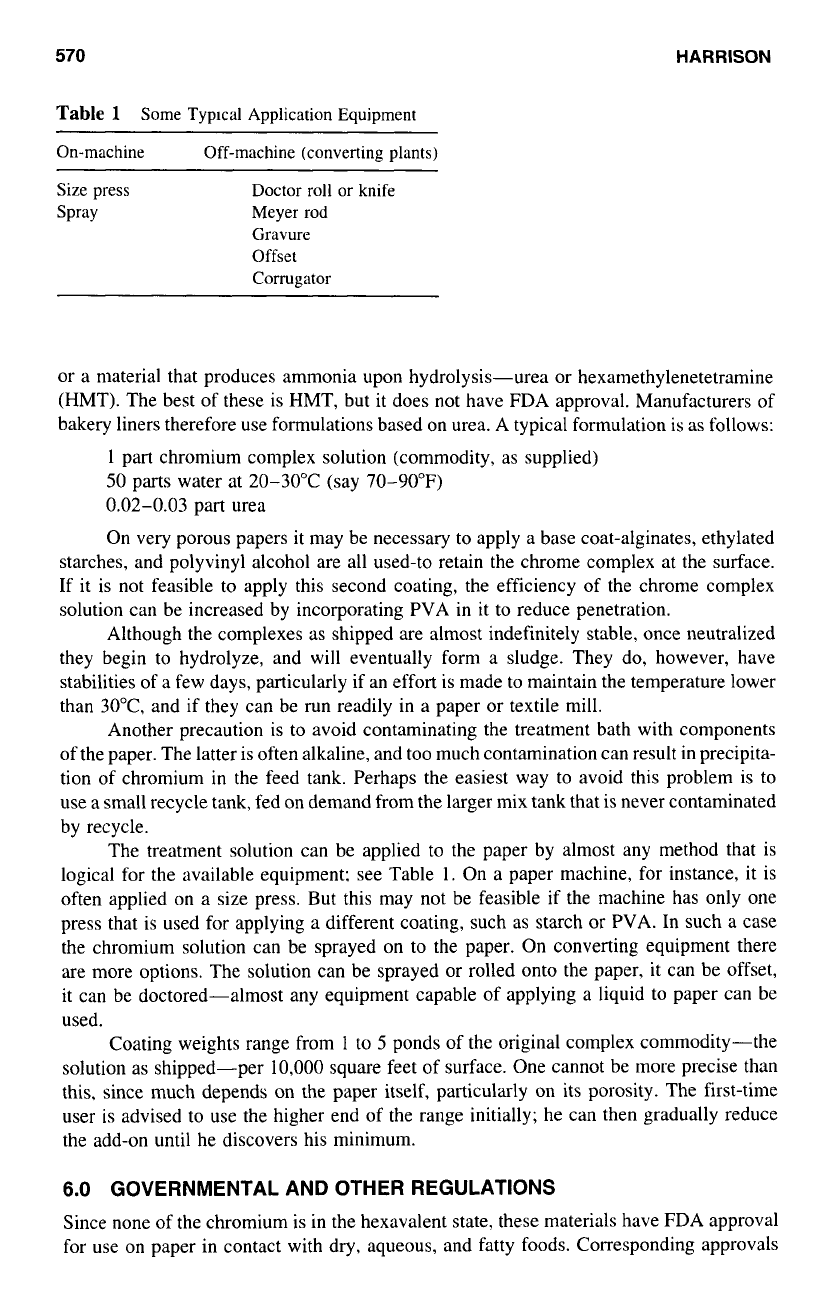
570
HARRISON
Table
1
Some Typ~cal Application Equipment
On-machine Off-machine (converting plants)
Size press Doctor
roll
or knife
Meyer
rod
Gravure
Offset
Corrugator
or a material that produces ammonia upon hydrolysis-urea or hexamethylenetetramine
(HMT). The best of these is HMT, but it does not have FDA approval. Manufacturers of
bakery liners therefore use formulations based on urea. A typical formulation is as follows:
1
part chromium complex solution (commodity, as supplied)
50 parts water at 20-30°C (say 70-90°F)
0.02-0.03 part urea
On very porous papers it may be necessary
to
apply a base coat-alginates, ethylated
starches, and polyvinyl alcohol are all used-to retain the chrome complex at the surface.
If it is not feasible
to
apply this second coating, the efficiency
of
the chrome complex
solution can be increased by incorporating PVA in it to reduce penetration.
Although the complexes as shipped are almost indefinitely stable, once neutralized
they begin to hydrolyze, and will eventually form a sludge. They do, however, have
stabilities of
a
few days, particularly if an effort
is
made to maintain the temperature lower
than 30°C and if they can be run readily in a paper or textile mill.
Another precaution is to avoid contaminating the treatment bath with components
of the paper. The latter is often alkaline, and too much contamination can result in precipita-
tion of chromium in the feed tank. Perhaps the easiest way to avoid this problem is to
use a small recycle tank, fed on demand from the larger mix tank that is never contaminated
by recycle.
The treatment solution can be applied to the paper by almost any method that is
logical for the available equipment; see Table
1.
On a paper machine, for instance, it is
often applied on a size press.
But
this may not be feasible
if
the machine has only one
press that is used for applying a different coating, such as starch
or
PVA. In such a case
the chromium solution can be sprayed on to the paper. On converting equipment there
are more options. The solution can be sprayed or rolled onto the paper, it can be offset,
it can be doctored-almost any equipment capable of applying a liquid to paper can be
used.
Coating weights range from
1
to
5
ponds
of
the original complex commodity-the
solution as shipped-per 10,000 square feet of surface. One cannot be more precise than
this, since much depends on the paper itself, particularly on its porosity. The first-time
user is advised to use the higher end of the range initially; he can then gradually reduce
the add-on until he discovers his minimum.
6.0
GOVERNMENTAL AND OTHER REGULATIONS
Since none
of
the chromium is in the hexavalent state, these materials have FDA approval
for use on paper in contact with dry, aqueous, and fatty foods. Corresponding approvals
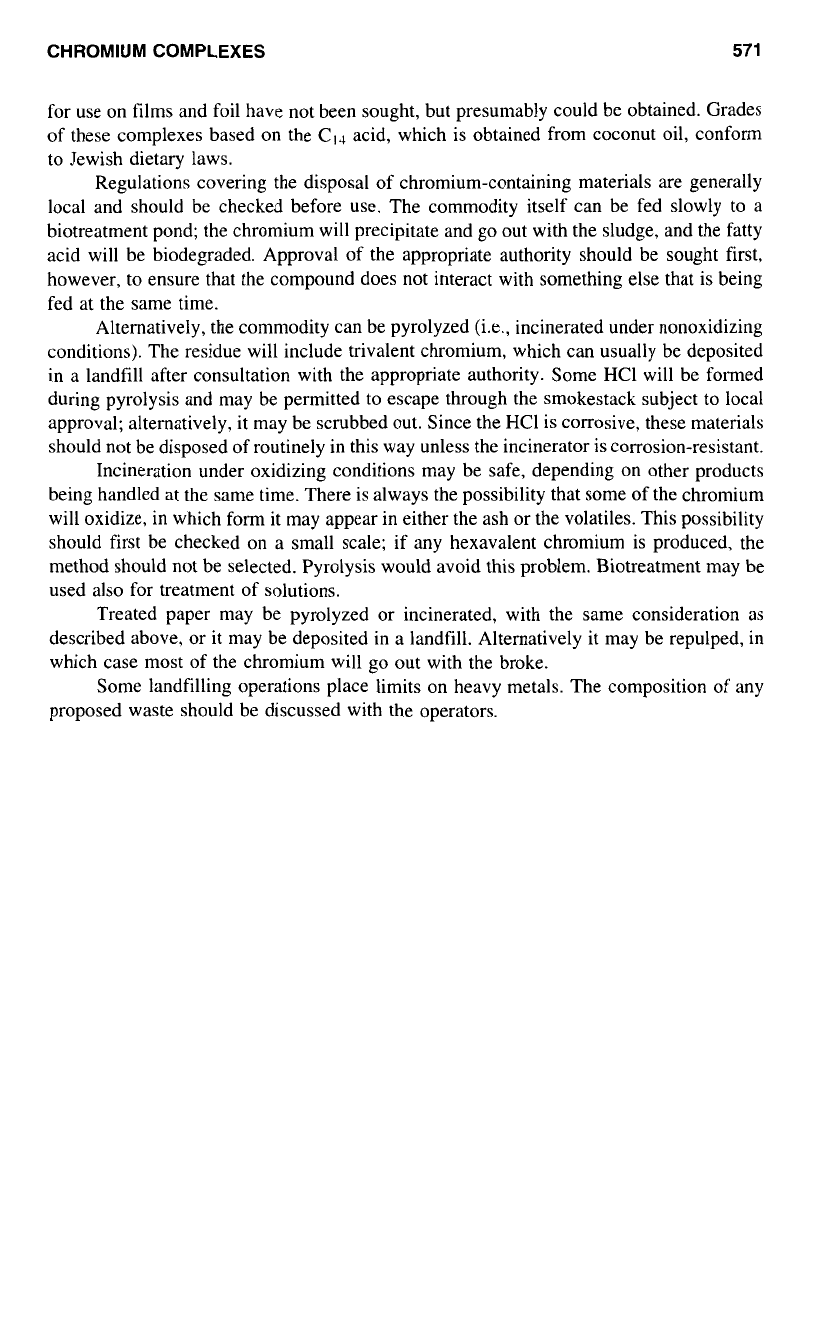
CHROMIUM COMPLEXES
571
for use on films and foil have not been sought, but presumably could be obtained. Grades
of these complexes based on the C14 acid, which is obtained from coconut oil, conform
to Jewish dietary laws.
Regulations covering the disposal of chromium-containing materials are generally
local and should be checked before use. The commodity itself can be fed slowly to a
biotreatment pond; the chromium will precipitate and go out with the sludge, and the fatty
acid will be biodegraded. Approval of the appropriate authority should be sought first,
however, to ensure that the compound does not interact with something else that is being
fed at the same time.
Alternatively, the commodity can be pyrolyzed (i.e., incinerated under nonoxidizing
conditions). The residue will include trivalent chromium, which can usually be deposited
in
a
landfill after consultation with the appropriate authority. Some HC1 will be formed
during pyrolysis and may be permitted to escape through the smokestack subject to local
approval; alternatively, it may be scrubbed out. Since the HCl is corrosive, these materials
should not be disposed of routinely in this way unless the incinerator is corrosion-resistant.
Incineration under oxidizing conditions may be safe, depending on other products
being handled at the same time. There is always the possibility that some of the chromium
will oxidize, in which form it may appear in either the ash
or
the volatiles. This possibility
should first be checked on
a
small scale; if any hexavalent chromium is produced, the
method should not be selected. Pyrolysis would avoid this problem. Biotreatment may be
used also for treatment of solutions.
Treated paper may be pyrolyzed
or
incinerated, with the same consideration as
described above, or it may be deposited in
a
landfill. Alternatively it may be repulped, in
which case most of the chromium will go out with the broke.
Some landfilling operations place limits on heavy metals. The composition of any
proposed waste should be discussed with the operators.
